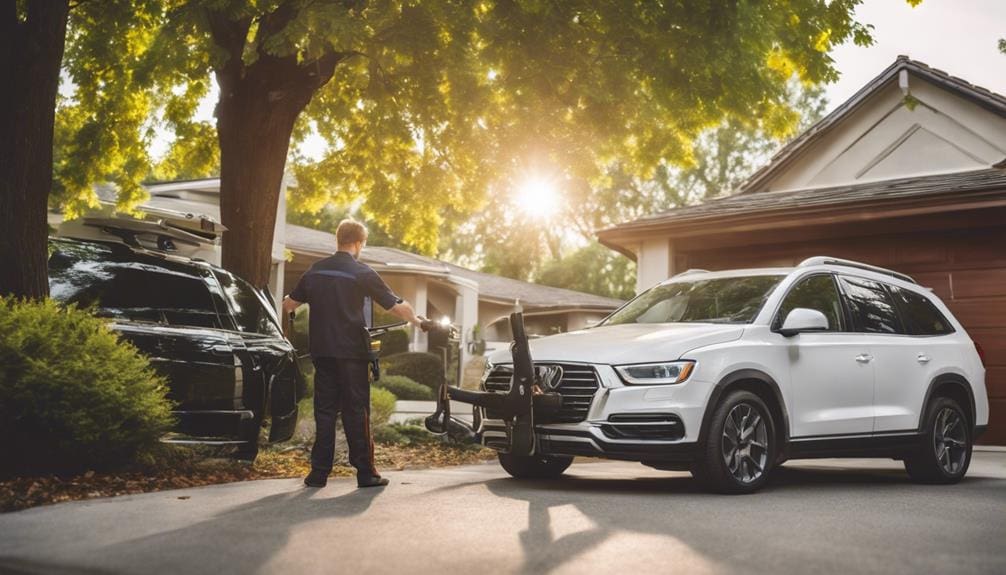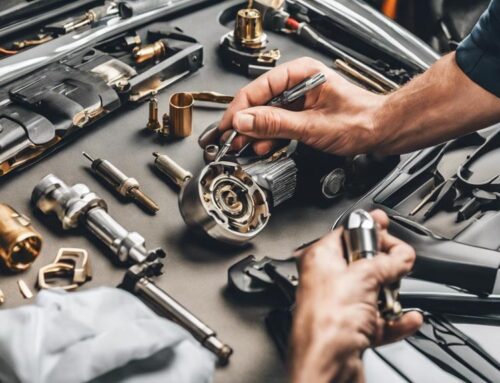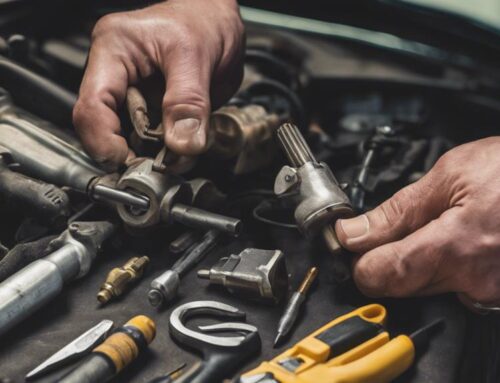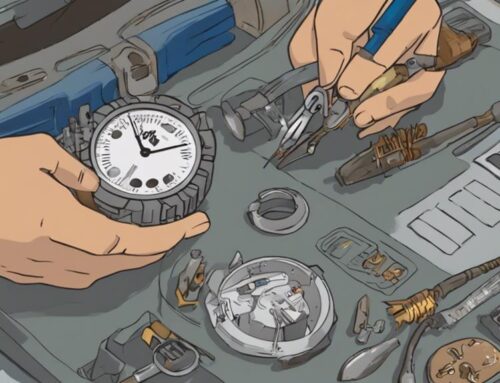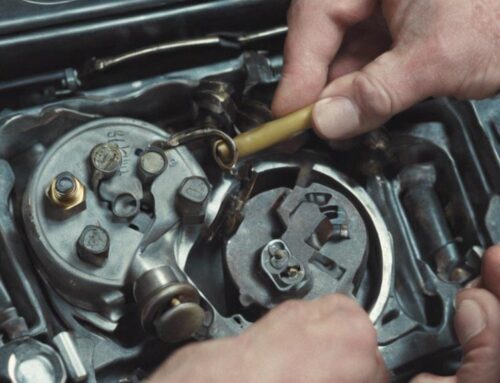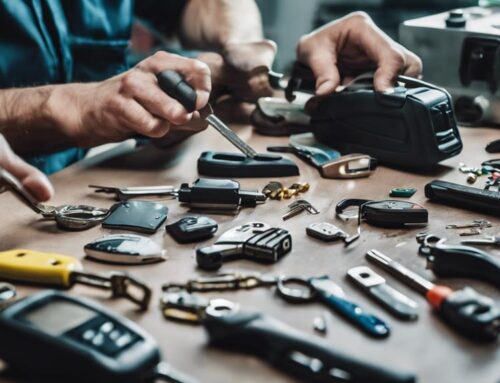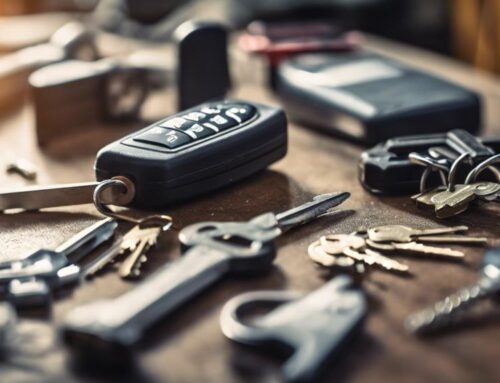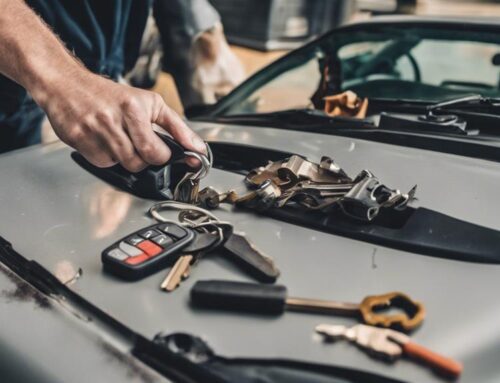Yes, a professional locksmith can access your car without its keys. They use techniques like the Slim Jim to manipulate internal linkages in the door or the Wedge and Rod method which involves careful maneuvering to access the door. Lishi tools provide precise control in interacting with the lock mechanism, while advanced methods like electronic lock bypass address modern car security systems. Professional locksmiths carry state-of-the-art tools and have deep expertise in non-destructive entry methods, ensuring your car remains unharmed. There’s much more to the process and benefits of professional locksmith services than you might think.
Key Takeaways
- Locksmiths use specialized tools like Slim Jims and Lishi tools to open cars without keys.
- Advanced techniques include electronic lock bypass for modern keyless entry systems.
- Non-destructive entry methods ensure the car remains undamaged during the lockout service.
- Locksmiths provide rapid response times, often arriving within minutes for immediate assistance.
- Services are available 24/7 with transparent pricing and a commitment to customer satisfaction.
Understanding Car Lockouts

Finding yourself locked out of your car can be a frustrating and inconvenient experience, often leading to delays and stress. When you’re faced with this situation, understanding the mechanics of car lockouts is essential. Modern cars come with complex locking mechanisms designed to enhance security. However, these same systems can become obstacles when keys are lost or locked inside the vehicle.
To regain entry, you need to comprehend how these locks operate. Car locks typically involve intricate electronic systems, including transponder chips and keyless entry fobs. These systems communicate with the car’s onboard computer, recognizing authorized keys and preventing unauthorized access. Physical locks, on the other hand, incorporate precision-engineered pins and tumblers that align perfectly with your key’s unique cuts.
Types of Car Locks
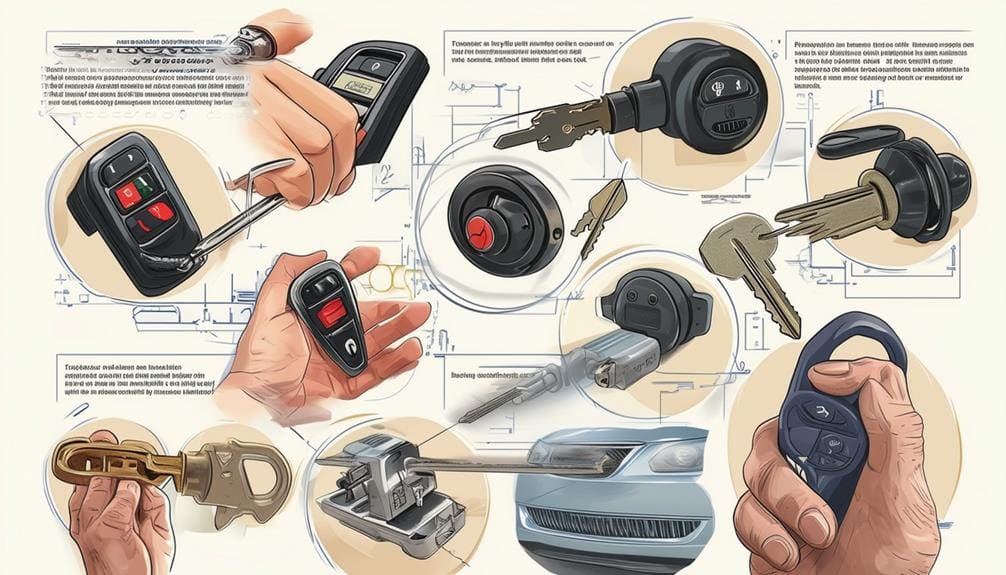
To effectively navigate the complexities of regaining entry to your car, it’s important to understand the various types of car locks and their specific mechanisms. Knowing the intricacies of these systems empowers you when faced with a lockout situation, and it also informs the locksmith on the best methods for accessing your vehicle.
- Traditional Keyed Locks: These are the most basic form of car locks, typically found in older models. They function using a simple mechanical key that engages with a series of pins inside the lock cylinder. Misaligning any pin prevents the lock from turning, making it secure but easier for a professional to pick.
- Electronic Key Fobs and Transponder Keys: Modern vehicles often employ these advanced mechanisms. A key fob emits a unique signal to the car’s receiver, allowing access to the doors. Transponder keys contain a microchip that communicates with the car’s ignition system, ensuring that only the correct key can start the engine.
- Smart Locks and Keyless Entry Systems: The latest innovation in automotive security, these systems use wireless technology to access the vehicle when the fob or smartphone is within a certain range. They often incorporate additional security features like fingerprint recognition or PIN codes, making unauthorized access more challenging.
Understanding these types of locks equips you with the knowledge to handle car lockouts more efficiently.
Slim Jim Technique
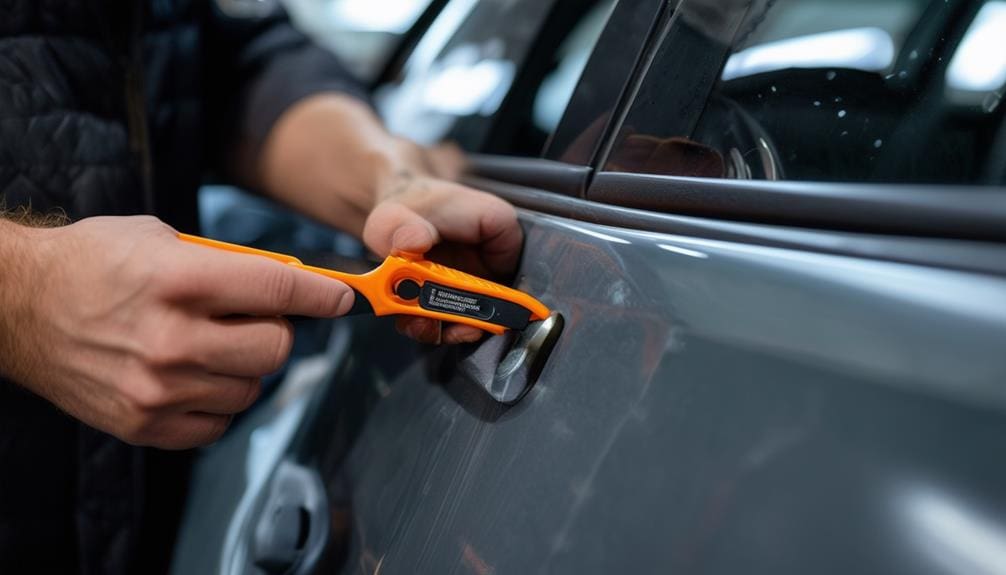
Mastering the Slim Jim technique allows you to access a car door by manipulating the internal linkages between the lock and the door mechanism. This method involves a flat, narrow tool, known as a Slim Jim, which slides between the window and the weather stripping on the car door. By feeling for and hooking onto the control rods or latch mechanisms inside the door, you can open the car without needing the keys.
Here’s a quick breakdown of the Slim Jim technique steps:
| Step | Action | Description |
|---|---|---|
| 1 | Insert | Slide the Slim Jim between the window and weather stripping. |
| 2 | Locate | Feel for the vertical rods or latch mechanisms. |
| 3 | Manipulate | Hook the control rod or latch mechanism. |
| 4 | Open | Gently pull or push to access the door. |
Precision is essential when using this technique to avoid damaging the internal components of the door. You must understand the specific lock mechanism of the vehicle you’re working on, as different car models have varying designs. It’s a highly effective method, but it demands skill and a steady hand to execute successfully.
Wedge and Rod Method
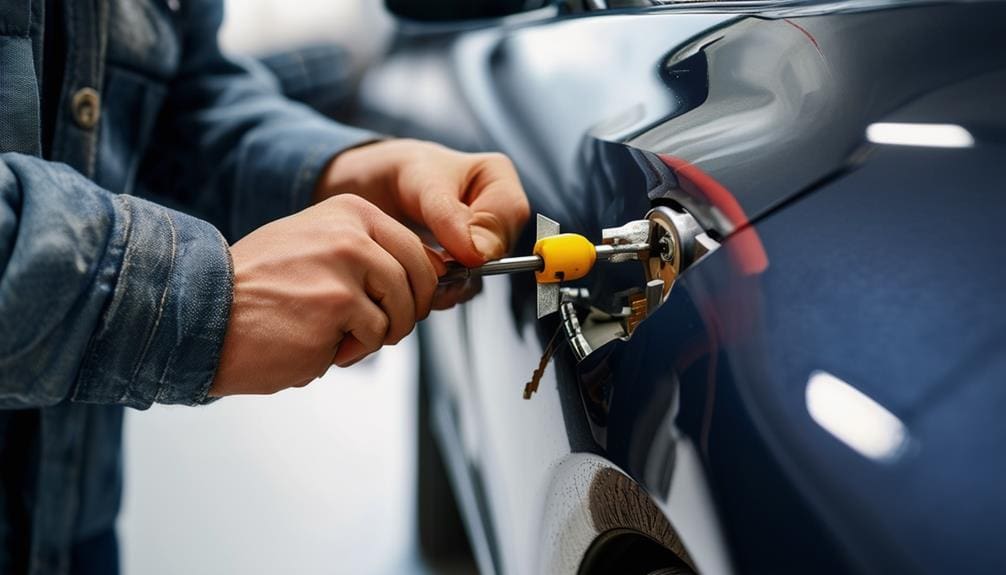
When using the wedge and rod method, you’ll start by carefully selecting the right tools to avoid damaging the vehicle. Next, follow precise steps to insert the wedge and maneuver the rod to open the door. Be aware of potential risks, such as damaging the weather stripping or scratching the paint.
Tool Selection Process
Choosing the appropriate tools for the wedge and rod method is crucial to ensure a successful and damage-free car lockout service. This method requires precision and the right equipment to safeguard you don’t harm the vehicle’s paint or internal mechanisms.
- Wedge: Opt for a high-quality wedge that can be easily inserted between the car door and frame. Look for one made from durable materials like plastic or rubber to prevent scratching the car’s finish. Inflatable wedges are particularly beneficial because they allow you to adjust the pressure gradually.
- Rod: Select a rod that’s strong yet flexible enough to maneuver inside the car. Telescoping rods are ideal as they can extend to various lengths, providing you the reach needed to engage the door lock or handle. Confirm the rod has a non-slip grip for better control.
- Protective Covering: Use protective coverings such as a plastic sleeve or padding for the wedge and rod. This additional layer will help safeguard the car’s interior and exterior from potential damage during the access process.
Technique Execution Steps
With the right tools in hand, you can now proceed to execute the wedge and rod method by following these precise steps to open the car without causing harm. First, insert a wedge into the top corner of the driver’s side door. Use a plastic or rubber wedge to prevent marks. Gently tap the wedge in to create a small gap, just enough to insert the rod.
Next, take the rod and carefully insert it through the gap created by the wedge. Aim to reach for the car’s open button or the door handle. It’s essential to maneuver the rod with precision to avoid damaging internal components. Once the rod is in place, press or pull the access mechanism.
After successfully accessing the door, remove the rod first, then carefully extract the wedge, ensuring you don’t mark the vehicle’s paint. This method requires patience and a steady hand to guarantee the car remains undamaged. If executed correctly, the wedge and rod method offers a quick and efficient solution to car lockouts, leveraging the power of technique and precision.
Potential Risks Involved
Despite its effectiveness, the wedge and rod method carries inherent risks that can compromise both the vehicle’s integrity and your safety. When you insert a wedge between the door frame and the car body, you create a gap that allows the rod to manipulate the lock mechanism. However, this approach can introduce several issues:
- Damage to Weatherstripping: The wedge can easily tear or compress the rubber weatherstripping around the door, leading to water leaks and increased wind noise.
- Scratches and Dents: Both the wedge and the rod can scratch or dent the paint and frame of your vehicle. This damage isn’t just cosmetic; it can lead to rust and corrosion over time.
- Airbag Deployment: Modern vehicles often have sensors in the door area for side airbags. Incorrectly placing the wedge can trigger these sensors, causing unintended airbag deployment, which can be both dangerous and costly.
To mitigate these risks, always use professional tools designed for automotive lockouts and make sure the person performing the procedure is highly skilled. Proper training and experience can greatly reduce the likelihood of these issues, preserving both your vehicle’s condition and your personal safety.
Lishi Tools Usage
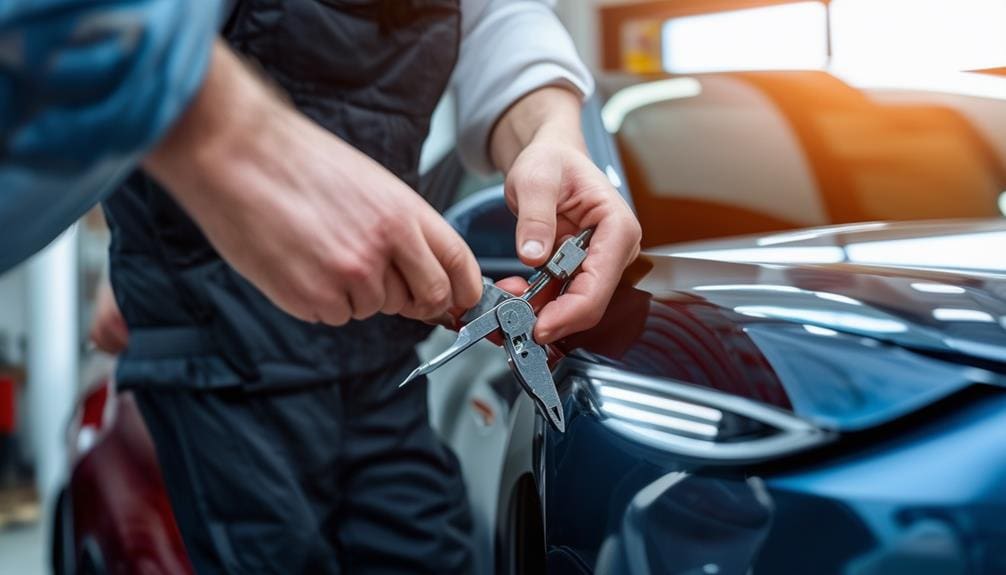
When using Lishi tools for car access services, you gain the advantage of precision and efficiency due to their design specifically tailored for automotive locks. These tools are engineered to interact directly with the vehicle’s lock mechanism, allowing you to manipulate the lock pins with exacting control. By leveraging the unique cuts and shapes on the Lishi tool, you can decode the lock and create a working key without causing any damage to the vehicle.
Mastering Lishi tools requires understanding the lock’s internal structure. As you insert the Lishi tool into the lock, you can feel each pin’s resistance and position, giving you real-time feedback. This tactile feedback is essential for accurately aligning the pins to open the car. The process is not only efficient but also minimally invasive, preserving the integrity of the lock system.
Moreover, Lishi tools come with a built-in decoder, allowing you to read the lock’s bitting with high accuracy. This feature is vital for creating a replacement key on the spot, enhancing your capability to resolve access issues swiftly. Utilizing Lishi tools empowers you to handle automotive access challenges with unmatched proficiency and confidence.
Keyless Entry Systems
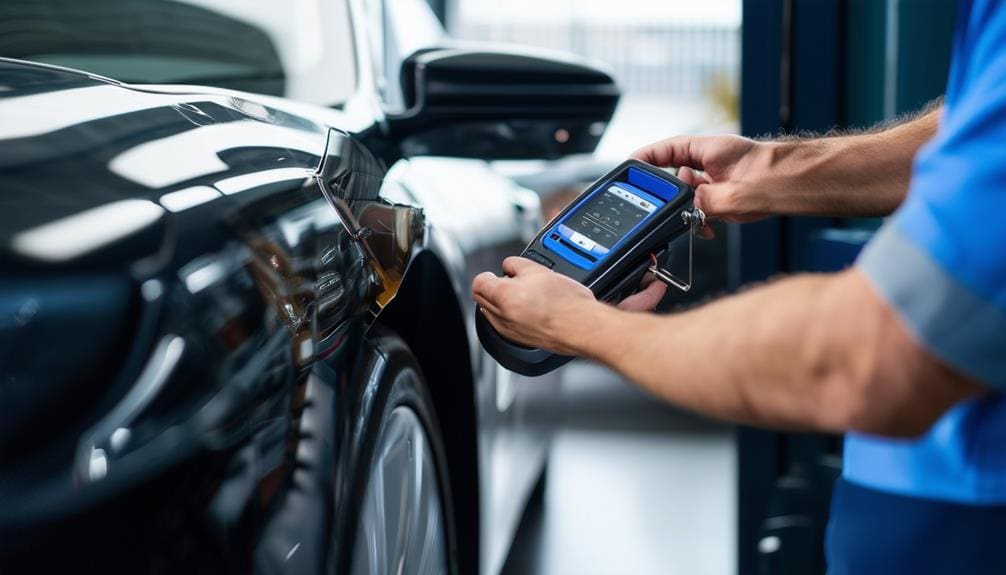
As automotive technology advances, keyless entry systems have become increasingly prevalent, offering a modern solution that eliminates the need for traditional keys altogether. These systems employ sophisticated technology to provide seamless access to your vehicle. Here’s how they work and what you should know:
- RFID (Radio Frequency Identification): Your car uses RFID to detect the presence of a key fob within a certain proximity. When the fob is near, it sends a unique code to the car’s onboard computer, allowing you to access the doors and start the engine without physical keys.
- Passive Keyless Entry (PKE): With PKE, you can access and start your car without even pressing a button. The system automatically recognizes the key fob as you approach, enabling you to open the door simply by pulling the handle. This offers a higher level of convenience and security.
- Mobile Apps and Digital Keys: Some modern vehicles now allow you to use your smartphone as a digital key. These apps enable you to lock, access, and start your car remotely. This feature integrates with advanced security protocols to guarantee your vehicle remains secure.
Understanding these components can empower you with the knowledge to fully utilize your vehicle’s keyless entry system, enhancing both convenience and security.
Transponder Key Issues
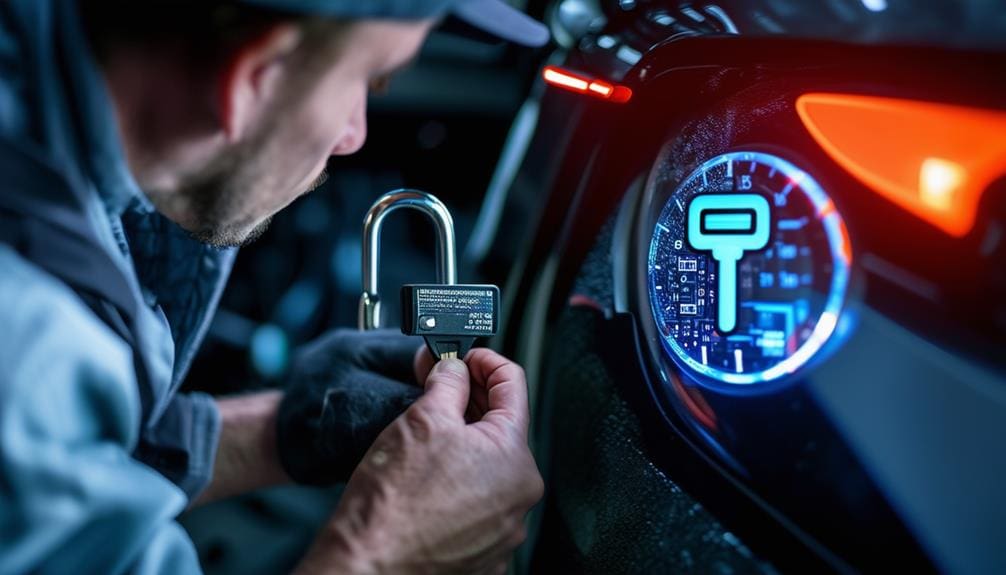
Dealing with transponder key issues can often be frustrating, especially given the sophisticated technology involved in their operation. Transponder keys contain a microchip that communicates with your car’s ignition system, ensuring that only your key can start the engine. When these keys malfunction, you might find yourself locked out or unable to start your vehicle.
First, check if the issue lies with the key’s battery. A depleted battery can prevent the transponder from sending the correct signal. If that doesn’t work, the key might need reprogramming. This requires specialized equipment and technical know-how, which professional locksmiths possess. They can reprogram your key to sync with your car’s electronic control unit (ECU), ensuring seamless operation.
Sometimes, the transponder chip itself can be damaged or corrupted. In such cases, a locksmith can either repair the existing chip or create a new transponder key altogether. They use advanced diagnostic tools to identify and resolve these issues efficiently.
Electronic Lock Bypass
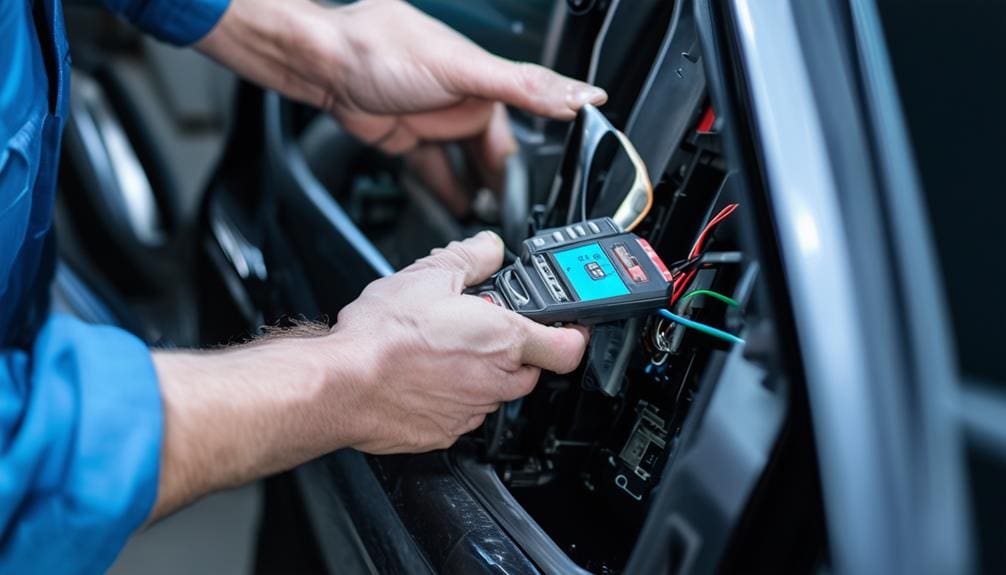
You’ll encounter electronic lock bypass when dealing with modern vehicles equipped with keyless entry systems. These methods often require specialized tools and knowledge to address the security system challenges without causing damage. Understanding these complexities guarantees you can provide efficient and secure lockout services.
Keyless Entry Methods
Keyless entry methods often involve sophisticated electronic lock bypass techniques that allow you to access your vehicle without a traditional key. These methods employ advanced tools and technologies that interact with your car’s electronic systems. As a savvy car owner, understanding these techniques can empower you to make informed decisions.
- Signal Amplification: Locksmiths use a device to capture and amplify the signal from your key fob, tricking the car into thinking the key is nearby. This method requires specialized equipment and knowledge of your car’s specific frequency.
- Onboard Diagnostics (OBD) Port Access: By connecting to the OBD port, a locksmith can reprogram the car’s system to accept a new key fob. This method is precise and requires expertise in automotive electronics and programming.
- Frequency Jamming: In some cases, locksmiths can employ frequency jamming techniques to disrupt the communication between the key fob and the car. This allows them to gain temporary access by bypassing the electronic lock.
These techniques highlight the power and precision of modern locksmith services. Understanding these methods not only helps you appreciate the expertise involved but also underscores the importance of choosing a reputable professional to handle your car lockout needs.
Security System Challenges
Understanding the complexities of electronic security system bypass often presents significant security challenges that require a thorough comprehension of your vehicle’s advanced systems. Today’s cars feature intricate electronic locking mechanisms, including transponder keys, keyless entry, and immobilizers. To navigate these, a locksmith must possess not only technical expertise but also sophisticated diagnostic tools.
Your vehicle’s security system is engineered to prevent unauthorized access, making electronic security system bypass a challenging task. It’s not just about opening a door; it’s about interfacing with encrypted data and circumventing security protocols designed to protect your asset. The locksmith must decode signals and manipulate the vehicle’s onboard computer systems without triggering alarms or immobilizing the engine.
Understanding these systems requires continuous training and access to proprietary software. Not all locksmiths can handle these sophisticated tasks. When you hire a professional, you’re ensuring that the person has the required skills and equipment to safely and effectively access your vehicle. Cutting corners here risks damage to your vehicle’s electronics and could compromise your vehicle’s security features. Always opt for a certified locksmith who specializes in modern car security systems to maintain the integrity and safety of your vehicle.
Non-Destructive Entry
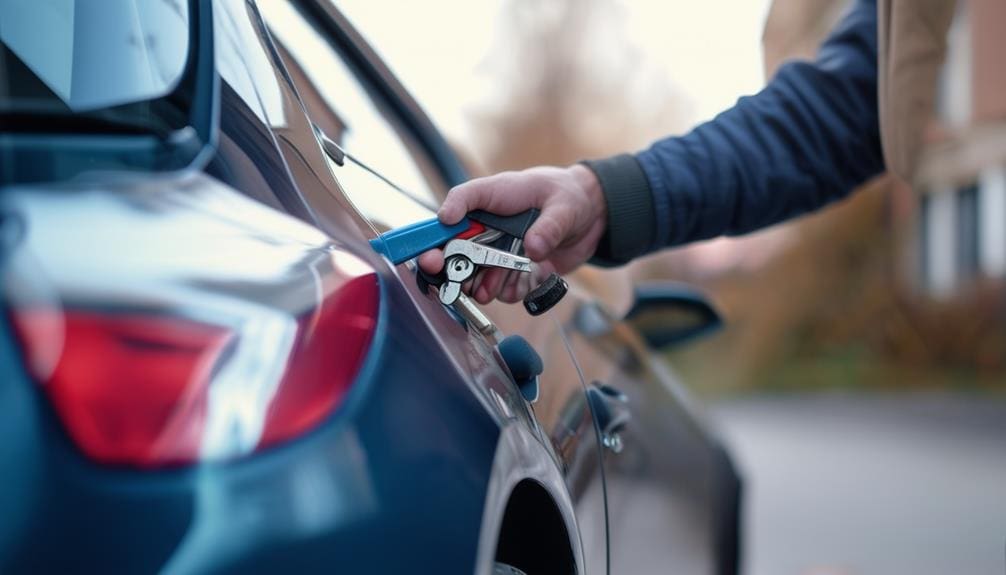
Non-destructive entry methods ensure that professionals can access a vehicle without causing any damage to the locks or the car itself. These methods are essential for maintaining the integrity of your vehicle, ensuring you don’t end up with costly repairs.
- Lock Picking: Skilled locksmiths use specialized tools to manipulate the lock mechanism directly. This requires in-depth knowledge and precision, ensuring the lock remains undamaged.
- Slim Jim: This tool slides between the car window and the weather stripping. By manipulating the internal linkages, a locksmith can access the door without touching the lock itself.
- Auto Jigglers: These are specially designed keys that mimic the shape of various car keys. When used correctly, they can access the door by aligning the internal components of the lock.
Each technique requires a high level of expertise and a deep understanding of automotive locking systems. A professional locksmith must be adept at quickly evaluating the situation and selecting the most appropriate method. They also stay updated with the latest advancements in car security to tackle modern locking mechanisms effectively. By using non-destructive entry methods, you can be confident that your vehicle will remain unharmed and secure.
Why Choose Low Rate Locksmith
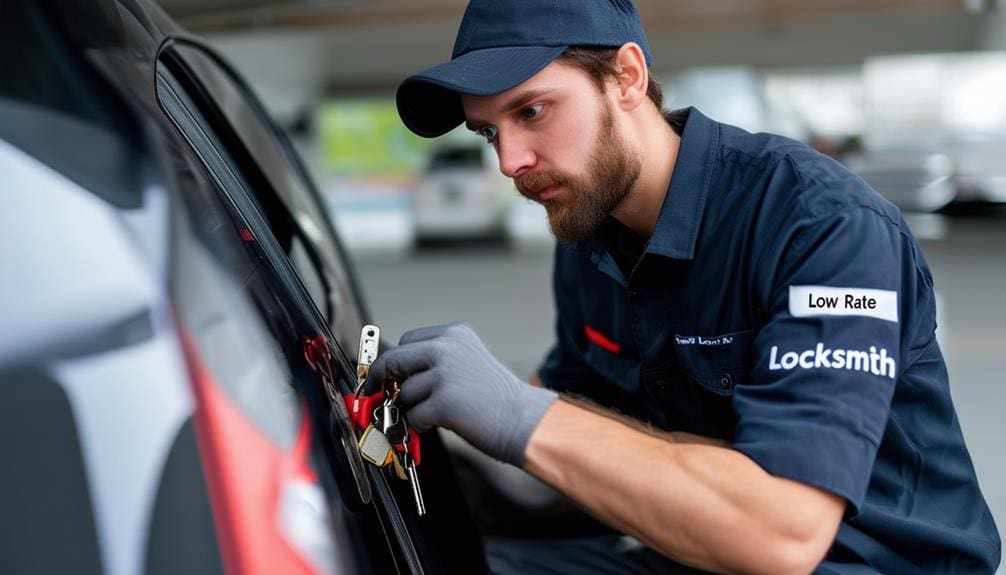
Choosing Low Rate Locksmith guarantees you benefit from skilled professionals who employ advanced, non-destructive entry techniques to safeguard your vehicle’s integrity while providing efficient and affordable car lockout solutions. Our technicians are rigorously trained and equipped with state-of-the-art tools, making sure that they can handle any lockout situation, regardless of the make or model of your car.
We understand the value of your time and aim to offer rapid response times, often arriving at your location within minutes. With Low Rate Locksmith, you’re not just getting a service; you’re investing in peace of mind. Our transparent pricing model ensures no hidden fees, giving you the confidence of knowing exactly what you’ll pay upfront.
Moreover, Low Rate Locksmith offers 24/7 availability, meaning you can count on us any time you’re in a bind. Our commitment to customer satisfaction is unmatched, demonstrated by our countless positive reviews and loyal clientele. By choosing us, you’re opting for reliability, speed, and professionalism. Trust in Low Rate Locksmith to turn a stressful situation into a hassle-free experience.
Frequently Asked Questions
What Should I Do Immediately if I Lock My Keys in the Car?
Immediately guarantee your safety, then contact a professional locksmith specializing in car lockouts. Provide them with your vehicle’s make and model for an efficient response. Meanwhile, avoid attempting to access it yourself to prevent damage.
Are There Any DIY Methods to Unlock a Car Without a Key?
When the rubber meets the road, you can try using a coat hanger or inflatable wedge to open your car. These methods require precision and care to avoid damage. Always proceed cautiously and keep a locksmith’s number handy.
Can Insurance Cover the Cost of Locksmith Services for Car Lockouts?
Yes, your insurance can cover locksmith services for car lockouts, but it depends on your policy. Check if you have roadside assistance or inclusive coverage, and make sure you understand the terms and potential deductibles.
How Long Does It Typically Take for a Locksmith to Unlock a Car?
Time is money, so let’s cut to the chase: a skilled locksmith typically takes about 5 to 10 minutes to open your car. They use specialized tools and techniques to guarantee minimal damage and maximum efficiency.
Is It Possible to Unlock a Car via Smartphone Apps or Remote Services?
Yes, you can access certain cars via smartphone apps or remote services. These technologies integrate with your vehicle’s systems, allowing you to control locks, start the engine, and even monitor security features directly from your phone.
Conclusion
To sum up, a locksmith can indeed unlock your car without keys using a variety of specialized techniques. Whether it’s a Slim Jim, wedge and rod, or Lishi tools, they have the skills to handle the job efficiently. Remember, ‘prevention is better than cure’; keep Low Rate Locksmith’s number handy for any future lockout emergencies. Their professional, non-destructive methods guarantee your car remains unharmed while getting you back on the road swiftly.

